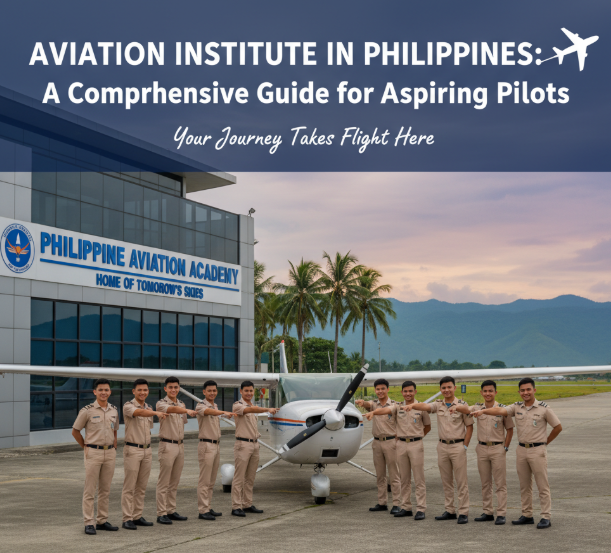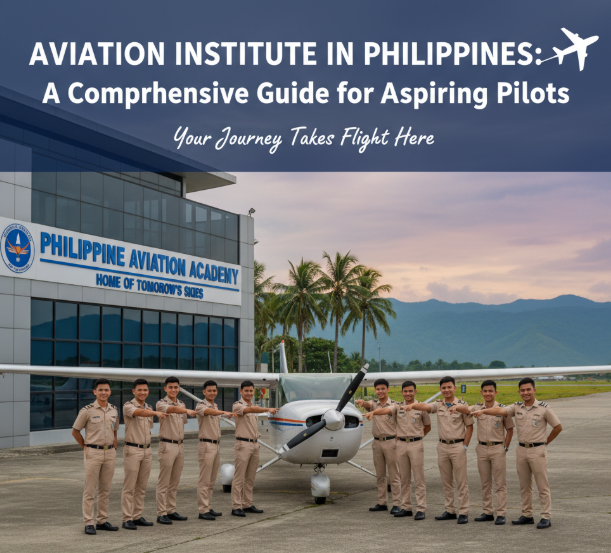
Introduction to Aviation Institute in Philippines
The aviation industry in the Philippines has seen remarkable growth over the years, becoming one of the critical pillars of the country’s infrastructure and economy. As air travel becomes more essential for both domestic and international connectivity, the role of aviation institutions in the Philippines has become more prominent. Aviation institutes offer comprehensive pilot training, along with courses for future aviation professionals, making the country an attractive destination for aspiring aviators.
Aviation institutes provide structured education and training for those wishing to pursue careers as pilots, flight instructors, or professionals in aviation management, maintenance, and air traffic control. In this guide, we will explore what an aviation institute is, its importance, the role it plays in the country’s development, the history of aviation in the Philippines, the opportunities for students, and much more.
Defining the Aviation Institute
An aviation institute is a specialized educational institution that offers programs and training related to aviation and aeronautics. These institutes typically offer courses that cover pilot training, aviation management, air traffic control, aerospace engineering, and other related fields. In the Philippines, aviation institutes primarily focus on training pilots, but they may also offer broader programs related to the aviation industry.
Aviation institutes in the Philippines often partner with local and international aviation bodies to provide students with the best education and practical training. With top-notch flight simulators and aircraft, these institutes offer hands-on training to equip students with the necessary skills to navigate the complex world of aviation.
Importance of Aviation in the Philippines
The aviation sector plays an integral role in the Philippines’ economy and infrastructure. With over 7,000 islands, air travel is often the most efficient way to connect various regions of the country. The industry supports trade, tourism, and economic growth by facilitating the movement of people and goods.
The Impact on Tourism
Tourism is one of the biggest sectors benefiting from aviation in the Philippines. The country is home to world-renowned beaches, islands, and natural wonders. Easy access to these destinations through domestic and international flights has made the Philippines a popular tourism hub. Consequently, there is an increasing demand for skilled pilots to operate flights within and outside the country.
Support for International Connectivity
The Philippines is an international hub for travel and commerce in Southeast Asia. The country’s international airlines, like Philippine Airlines, Cebu Pacific, and AirAsia Philippines, serve a vast network of global destinations. A strong, well-trained workforce is crucial to sustaining and expanding this international connectivity, thus making aviation institutes an essential part of the future of the industry.
History and Development of Aviation in the Philippines
Early Aviation History of the Country
The Philippines has a rich history in aviation. The country’s aviation journey began in the early 20th century when it first opened to commercial aviation. In 1941, Philippine Airlines (PAL) was established, making it the oldest airline in Asia. The development of aviation infrastructure in the country accelerated in the post-war years, and the government recognized the importance of training local pilots to support the growing airline industry.
During the 1960s and 1970s, aviation in the Philippines continued to expand as the industry became more interconnected with global air travel networks. The emergence of low-cost carriers and the increased importance of regional airports also reshaped the landscape of aviation training in the country.
Milestones in the Aviation Sector
- Philippine Airlines (PAL): As the oldest airline in Asia, PAL set the foundation for the development of aviation in the Philippines.
- Cebu Pacific: Founded in 1996, Cebu Pacific became the first low-cost airline in the Philippines and revolutionized the domestic flight sector.
- Clark International Airport (CRK): This modern airport has further boosted the country’s global connectivity, reinforcing the need for well-trained aviation professionals.
Military Aviation and Space Programs
In addition to civilian aviation, the Philippines has also contributed to military aviation. The Philippine Air Force has been active since the 1940s, and the country has participated in international defense and humanitarian missions.
The Philippines has expressed interest in space exploration, with initiatives aimed at developing satellite technology and fostering partnerships with space agencies like NASA.
Current Role of Aviation Institutes in the Philippines
Aviation institutes in the Philippines play a vital role in supporting the country’s growing aviation sector. These institutions function as training grounds for the next generation of pilots and aviation professionals, ensuring that the industry is equipped with highly skilled personnel.
Civil Aviation Training
Aviation institutes provide civil aviation training, primarily for those seeking careers as airline pilots. The training programs usually cover a wide range of subjects, including aircraft systems, flight planning, navigation, meteorology, and aviation law.
Defense and Security
Some aviation institutes also contribute to the Philippines’ defense and security sectors by offering specialized training for military pilots and aviation professionals. This partnership between educational institutions and the armed forces helps in the development of personnel who can efficiently handle military aircraft and defense systems.
Space Exploration
While still in its early stages, space exploration in the Philippines is growing. The Philippine Space Agency (PhilSA) has been set up to coordinate space missions and satellite technology. Aviation institutes are beginning to recognize the importance of space exploration and are introducing specialized courses to prepare students for future roles in this field.
Eligibility, Training, and Skills Required
Basic Qualifications
The eligibility requirements for entering an aviation institute in the Philippines may vary depending on the program, but generally, candidates must meet the following basic criteria:
- Education: A high school diploma is the minimum requirement for most programs. Some institutes may also require candidates to have completed a college degree or specific courses in science and mathematics.
- Health: Aspiring pilots and aviation professionals must undergo medical assessments to ensure they meet the necessary physical fitness standards for flight.
- Age: Most institutes have age requirements, with the typical range being 17–30 years old for pilot training programs.
Technical and Soft Skills
To succeed in aviation training, candidates need to develop both technical and soft skills:
- Technical Skills: Navigation, meteorology, aviation regulations, and aircraft systems knowledge are critical.
- Soft Skills: Communication, leadership, teamwork, and problem-solving are essential for working in aviation environments.
Institutes, Academies, and Training Centers in the Philippines
Several renowned aviation institutes and academies offer pilot training and other aviation-related programs in the Philippines. Some of the top institutions include:
1. Philippine State College of Aeronautics (PhilSCA)
PhilSCA offers a wide range of aviation programs, including pilot training, air traffic control, and aviation management. It is known for its strong focus on both theoretical knowledge and practical skills.
2. Aviation Institute of the Philippines (AIP)
AIP is one of the leading aviation schools in the country, offering comprehensive programs in pilot training, aircraft maintenance, and aviation management.
3. FilAmerican Aviation School
FilAmerican Aviation School is another prominent institution, providing pilot training programs that focus on preparing students for both commercial and private aviation careers.
4. Mactan Aviation Academy
Located in Cebu, Mactan Aviation Academy offers professional pilot training and a variety of other aviation-related courses.
5. Palawan State University Aviation Program
Palawan State University offers a well-regarded aviation program that trains students for roles in piloting, aircraft maintenance, and air traffic control.
Government Initiatives
The Philippine government plays a critical role in regulating and supporting the aviation industry through the Civil Aviation Authority of the Philippines (CAAP) and the Department of Transportation. Government initiatives, such as upgrading airport infrastructure and promoting public-private partnerships, help shape the future of aviation training in the country.
Technology and Innovation in Aviation Training
Aviation institutes in the Philippines are increasingly incorporating the latest technology and innovation into their training programs. Flight simulators, AI-assisted navigation systems, and digital cockpits are just a few examples of how modern technology is being utilized to prepare students for real-world scenarios.
The Role of Global Agencies
International agencies like NASA, the International Civil Aviation Organization (ICAO), and the European Space Agency (ESA) are shaping the future of aviation. Collaboration with these agencies provides local institutions with the latest research, technology, and training resources.
Challenges Faced in Pilot Training in the Philippines
Despite the growth of the aviation sector, there are several challenges that institutions face:
Infrastructure Gaps
Limited airport facilities and a shortage of training aircraft can pose challenges for aviation schools. These institutions need more investment to maintain state-of-the-art facilities.
High Costs
Pilot training can be expensive, with many students relying on loans or sponsorships to fund their education. The high cost can be a barrier for many aspiring pilots.
Regulatory Hurdles
The regulatory environment in the Philippines sometimes presents challenges in streamlining training programs and certifications, which can delay the entry of pilots into the workforce.
Brain Drain
Many trained pilots leave the Philippines to work for international airlines, which creates a talent gap in the domestic aviation industry.
Future of Aviation Institutes in the Philippines
Space Tourism and Private Aviation
The future of aviation in the Philippines looks bright with the growth of space tourism and private aviation. Aviation institutes will need to adapt their curriculums to incorporate spaceflight training and the development of private jet services.
National Projects and Innovation
National projects like the Philippine Space Program (PhilSA) and international collaborations will bring new opportunities for aspiring pilots and aviation professionals.
Career Path & Opportunities
The career path for an aviation professional in the Philippines typically involves:
- Education: Completing a relevant program from an accredited aviation institute.
- Pilot License: Earning a private or commercial pilot license.
- Advanced Training: Pursuing specialized training for different aircraft and flying environments.
- Job Opportunities: Working for airlines, private aviation companies, or government agencies.
FAQs
- How much does pilot training cost in the Philippines?
The cost of pilot training in the Philippines can range from PHP 500,000 to PHP 1.5 million, depending on the institution and the type of program. - Which is the best aviation institute in the Philippines?
Institutes like the Philippine State College of Aeronautics and the Aviation Institute of the Philippines are among the best, offering comprehensive training programs. - What qualifications are needed for pilot training in the Philippines?
A high school diploma, a medical certificate, and basic physical fitness are generally required for pilot training programs. - Is international flight training available in the Philippines?
Yes, many aviation schools in the Philippines offer internationally recognized programs that allow graduates to work with international airlines. - What is the future of aviation in the Philippines?
With the rise of space tourism, private aviation, and modernized infrastructure, the future of aviation in the Philippines looks promising.
Conclusion
Aviation institutes in the Philippines play a critical role in shaping the future of the aviation industry. By providing top-notch training and embracing new technologies, these institutions help ensure that the next generation of pilots and aviation professionals are well-equipped for success. If you are considering a career in aviation, the Philippines offers an exciting and dynamic environment to begin your journey.
